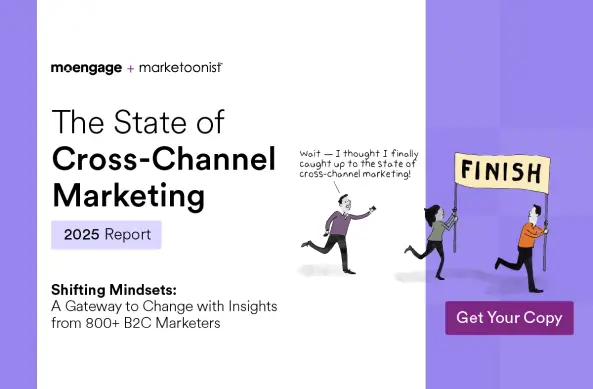Personalized Push Notifications: Use Cases and Real-Life Examples
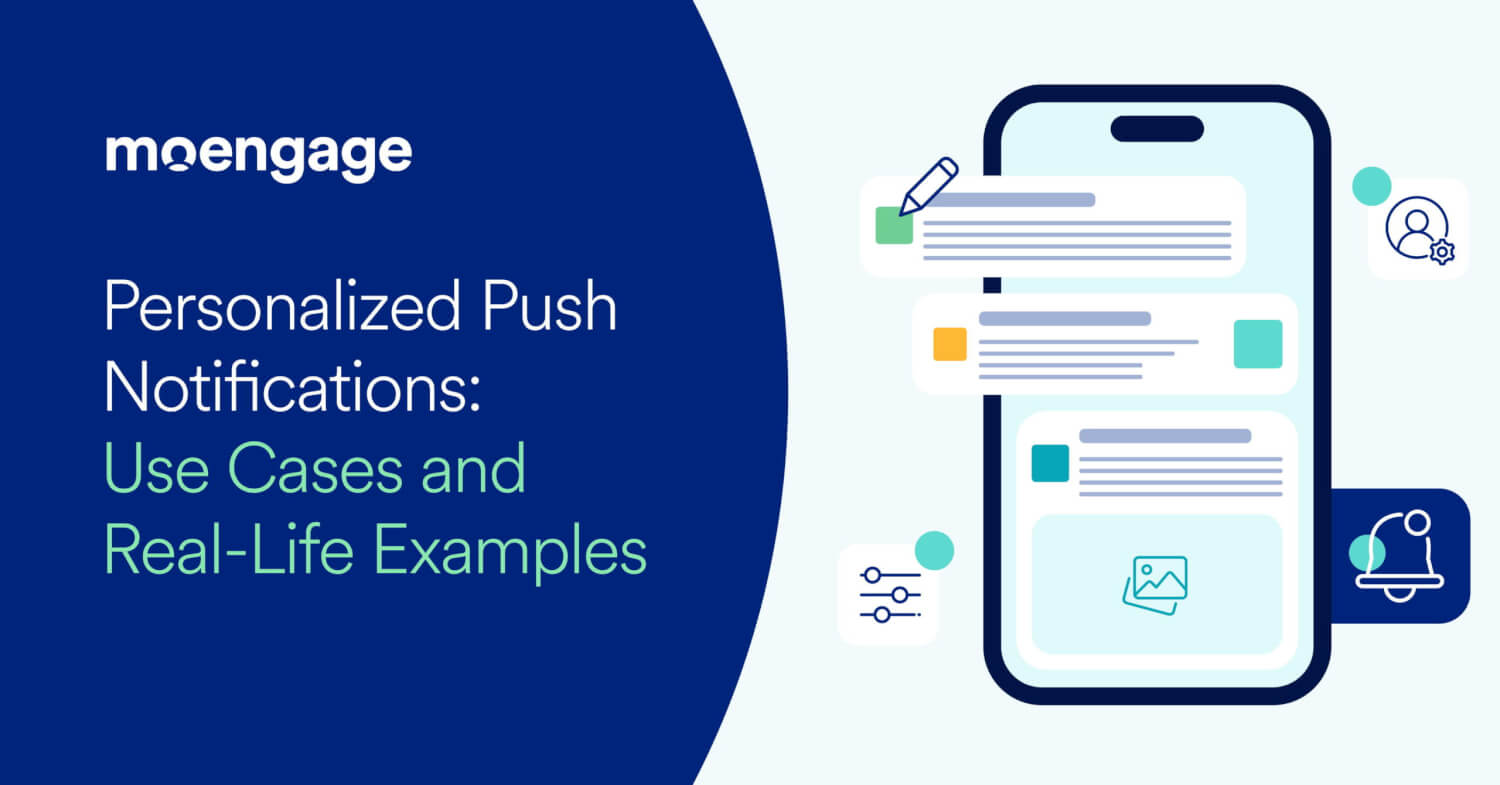
Reading Time: 11 minutes
Imagine this:
✨ It’s your birthday, and you’re having a great time with your friends at the mall.
Suddenly, your phone vibrates, and you see a push notification from your favorite store in the mall.
Surprise!
It’s a 30% discount, limited-time only, coupon, just for you on your special day.
Now, you remember something you saw while browsing online and decide to pay them a visit. ✨
Personalized push notifications like these are popular among marketers and consumers alike.
Rising smartphone usage coupled with greater consumer expectations around tailored purchasing experiences makes it an intelligent move to invest in personalized push notification campaigns.
In this guide, we’ll explore push notification marketing, how it differs from other forms of channel marketing like email, and real-life examples that you can replicate in your own push notification marketing strategy.
Let’s get to it.
What is Push Notification Marketing?
Push notification marketing is the practice of sending pop-up messages to customers on their smartphones or browsers via an app or website. They typically include information about products or services and are meant to encourage customers to take a desired action, such as making a purchase, using a discount code, or subscribing to an email list.
Push notifications can be promotional or transactional in nature. With the former, brands raise awareness about their products, send updates, and advertise offers and discounts. Transactional notifications inform customers about things like their order status, transactional alerts, membership expiration alerts, and more.
What are Personalized Push Notifications?
Personalized push notifications refer to customized notifications that are sent to individual customers on their mobile devices or web browsers. They are based on their demographic information, location, preferences, behavior, and previous interactions with the brand.
Unlike generic notifications that are sent to a broad audience, personalized push notifications aim to deliver relevant content, product information, promotions, or reminders that help to increase subscriptions, downloads, customer engagement, conversion rates, and the overall app or website user experience.
By leveraging customer insights and segmentation, personalized push notifications offer more value and relevance, thereby improving customer satisfaction and driving the desired actions.
To be relevant and valuable, such notifications must be delivered in real-time, at the right moments, and to the right customers.
For example, if a customer frequently views a particular brand of shoes on a website, the brand can send them a personalized push notification offering a discount coupon for a newly launched pair of shoes by the same brand.
Our Personalization Pulse Check report reveals that 27.7% of North American customers want their communication personalized based on purchase history, whereas 22.7% of customers want factors such as repeat purchases, favorite categories, and wishlist items to be taken into account.
| 💡 Grab your copy of MoEngage’s Personalization Pulse Check report for North America to understand your customers better than ever. |
A real-life example is Spotify’s personalized push notifications. The brand sends messages encouraging customers to discover new music based on their listening habits and preferences. As a result, the recommendations are highly relevant, leading customers to explore new artists on the platform.
5 Ways to Execute a Push Notification Marketing Strategy
Various push notification strategies, done smartly, can help you increase subscriber count, boost engagement, and drive conversions.
Here are some strategies that you can implement:
1. Cart abandonment campaigns
Baymard Institute pegs the average cart abandonment rate at 70.19%.
Consumers abandon carts for various reasons, such as high shipping costs, forced account creation, complex checkout, bad website experience, and the absence of a preferred payment option.
Cart abandonment push notifications are subtle reminders that help re-engage high purchase intent customers and bring them back to the sales funnel.
Studies show that cart abandonment push notifications typically have a click rate of 16%.
For example, UNIQLO sends abandoned cart notifications with a drop in price as an incentive to capture the attention of its customers.
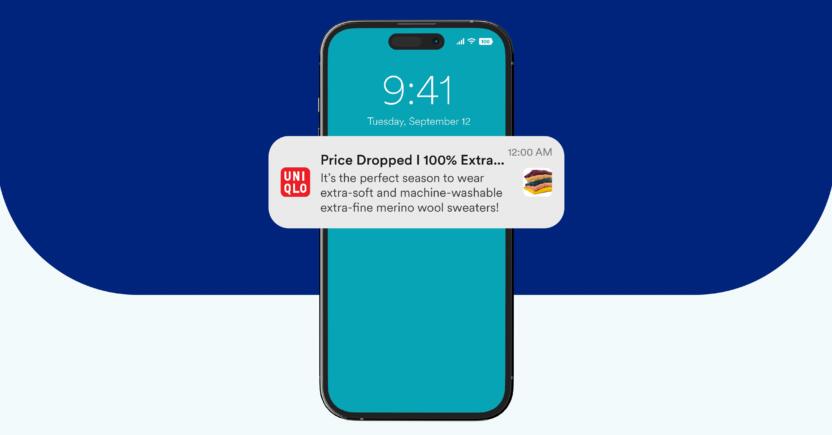
To determine if your cart abandonment push notifications are hitting home, you can measure the conversion rate.
Conversion rate refers to the percentage of push notifications that lead to a successful outcome, such as a sale or subscription.
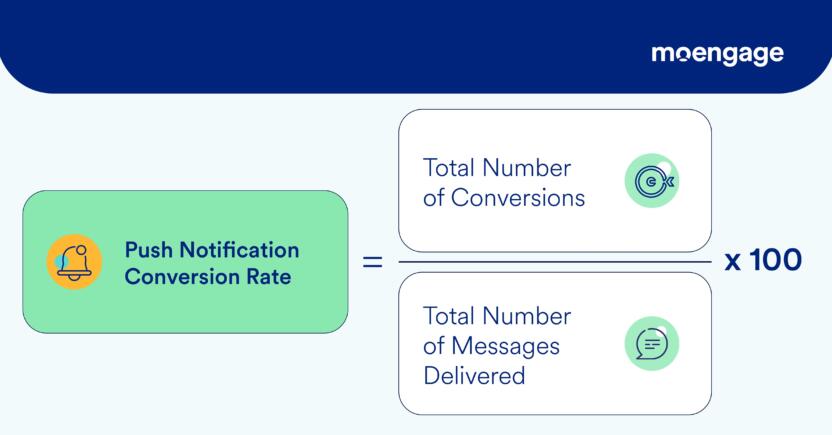
A high conversion rate means your push notifications are able to influence your consumers’ decisions and actions.
2. Run limited-time offers
Studies show that promotions are the most-desired (34%) form of push notification content.
Informing your customers about limited-time deals, especially during the festive season and live events triggers FOMO and creates a sense of urgency, resulting in the customer taking immediate action.
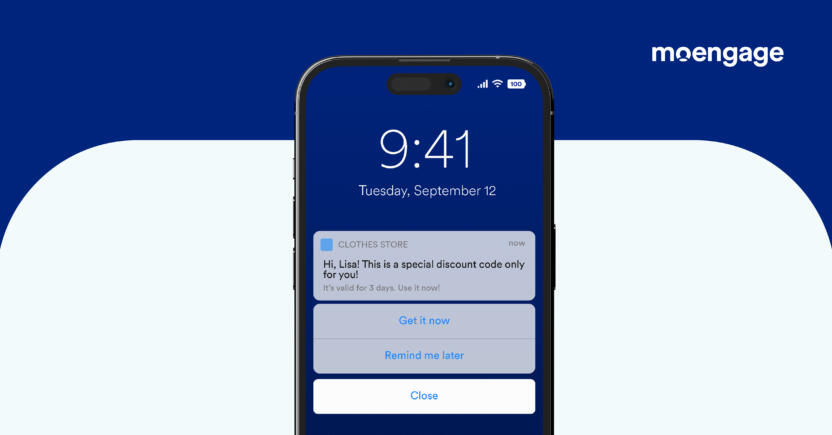
To measure whether this type of campaign is working, measure the click-through rate (CTR).
CTR refers to how many customers clicked on the notification to reach the linked page, out of the total notifications that were successfully delivered.
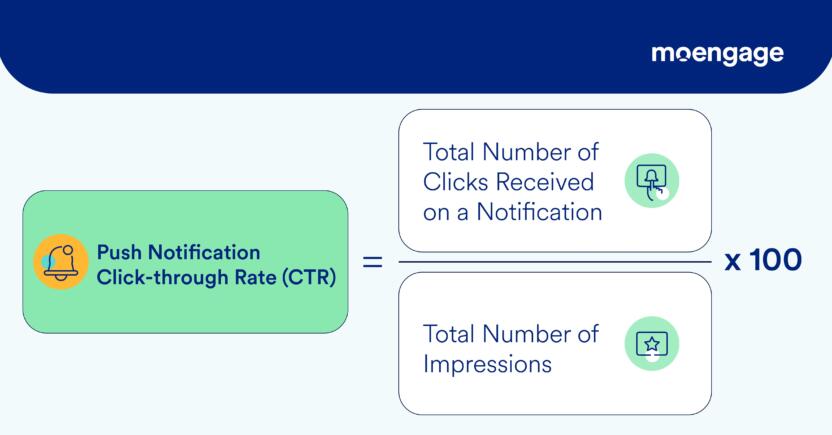
Studies show that the average click rate of web push notifications is 12%, which can be improved to 15% by push notification automation and 18% with the inclusion of rich media.
3. Browsing abandonment campaigns
When a customer viewing your website or app bounces without taking any action or adding anything to their cart, you can send them a browsing abandonment push notification.
This is a reminder that they were browsing a product or service of interest on your platform. And it helps to bring them back to your platform, increasing their in-session time and the chances of conversions.
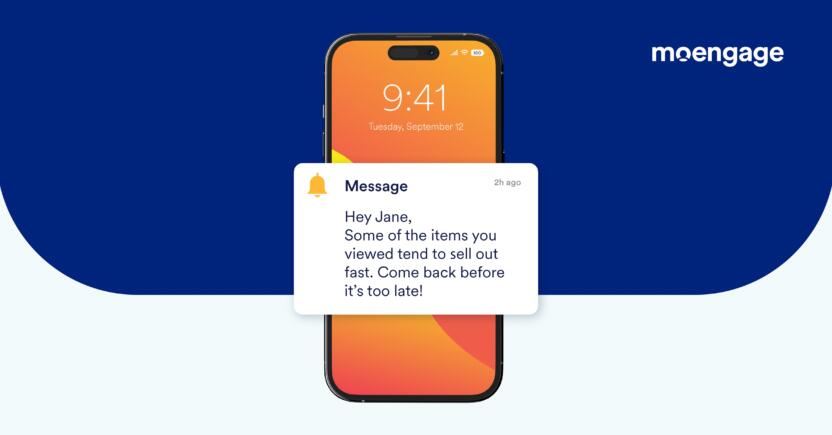
How do you know it’s working?
Measure the CTR and the average session duration of the customers who clicked the push notification.
This will not only give you insights about your push notification but also your app/website.
A high average session duration means the push notifications are compelling and your customer journey orchestration aligns with consumer motivations.
4. Location-based notifications
Location-based push notifications allow you to execute hyper-personalization.
They involve detecting the customer’s location by GPS and sending them location-specific alerts and deals. This hybrid approach enables you to trigger messages when your customers are most likely to act on them.
However, the content in your push notification and the offer you provide must be compelling enough to urge the customer to deviate from their original plan.
| 💡 Pro tip: Merlin AI, MoEngage’s Generative AI Engine understands past campaign performance data, historical keywords, campaign goals, and channel dynamics to create personalized, channel-specific content that resonates with customers. You can use it to build high ROI-driving push notification campaigns. |
For example, Sephora uses geofencing at airports to send cleverly worded push notifications that target travelers’ pain points—TSA confiscating makeup.
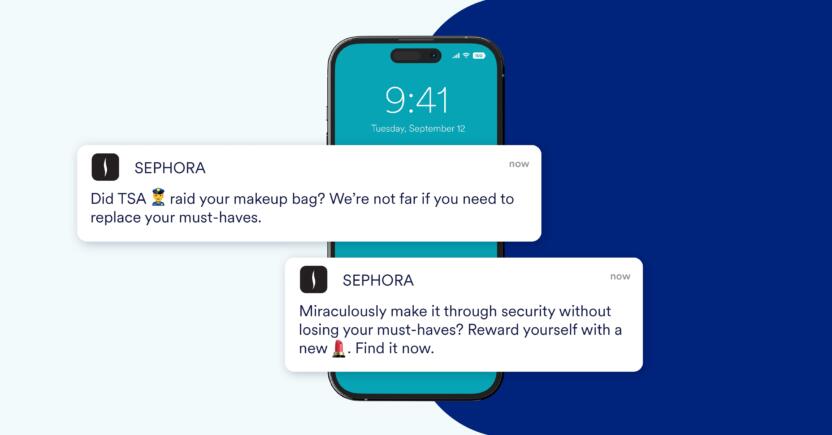
A good way to measure if location-based push notifications are working is to check the CTR. This leads to more website/app opens and, eventually conversions.
Some studies show that location-based messaging can lead to a 45% CTR.
5. Birthday, anniversary, and milestone offers
Celebrate customer milestones, anniversaries, or birthdays by offering discounts, special offers, or free company swag. Customers enjoy surprises, and this is a great marketing strategy to ensure customer engagement and build loyalty.
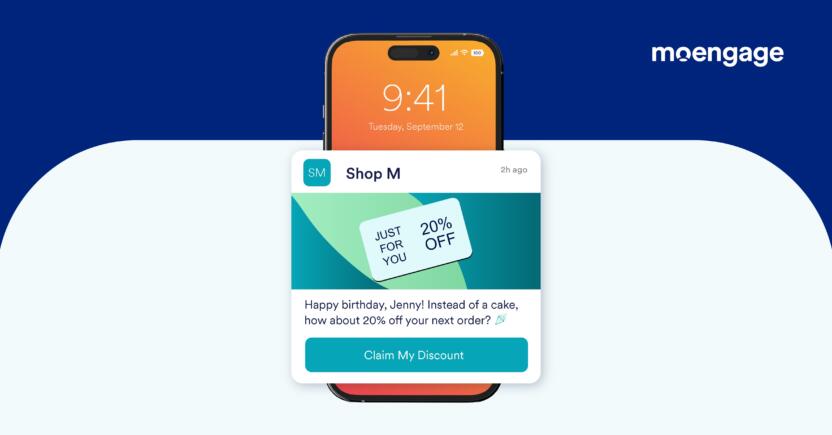 CTRs and conversion rates are a good measure of whether this strategy is working well for you.
CTRs and conversion rates are a good measure of whether this strategy is working well for you.
4 Push Notification Marketing Examples and Ideas
Successful push notification marketing adapts to customer behavior and preferences.
Here are some examples to inspire you:
1. JibJab increased CTR by 30% with personalized push notifications
JibJab, a digital entertainment studio from Los Angeles, wanted to boost customer engagement outside of the traditionally busy festival times and special occasions.
Using MoEngage, the brand:
- Mapped various active and dormant paths and found common customer drop-off points, across the customer journey.
- Identified the best-performing channels, and ideal messaging frequency and sequence.
- Sent hyper-personalized messaging using push notifications (and other channels like in-app messaging).
- Implemented Best Time to Send to further optimize and personalize campaigns.
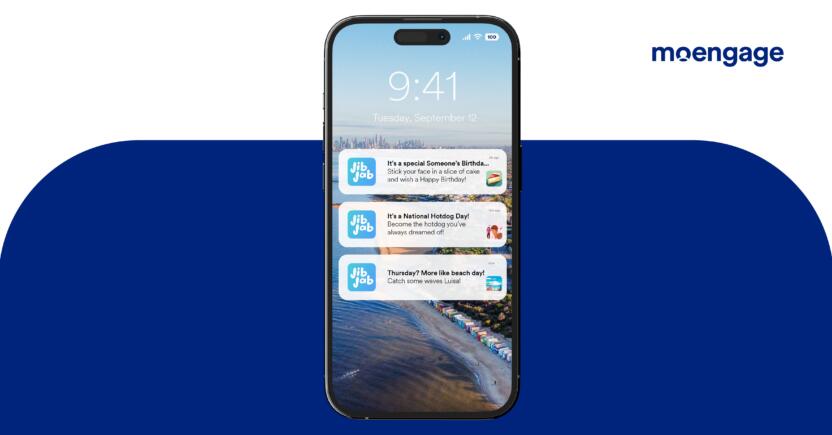
Why was this so powerful?
JibJab got a bird’s-eye view of the steps customers took from one journey stage to another. Based on this and other customer insights, the brand triggered automated push notifications embedded in elaborate workflows to encourage customers to create and share more content or remind them about upcoming events.
Sending personalized push notifications resulted in a 30% increase in CTR compared to the non-personalized push notifications sent earlier.
| 💡 Read the full JibJab case study to know more. |
2. Landmark Group saw a 56% uplift in purchases during their White Wednesday sale
Landmark Group is a multinational conglomerate that owns 2,300 outlets in over 22 countries.
For their White Wednesday Sale 2019, they wanted to increase subscribers and conversions.
Using MoEngage’s in-app, push notification, and Dynamic Product Messaging capabilities, the brand ran White Wednesday-focused offers to engage customers on the app before, during, and after the sale.
These campaigns were powered by demarcating customers into different segments based on factors like purchase history, search history, whether they had opted-in to receive push notifications, etc.
The messaging was differentiated based on these segments. For example, the segment including less active customers was sent communication promoting the benefits of the sale. Similarly, active customers were sent communication promoting the use of wishlist functionality within the app, slashed prices, and gifting options.
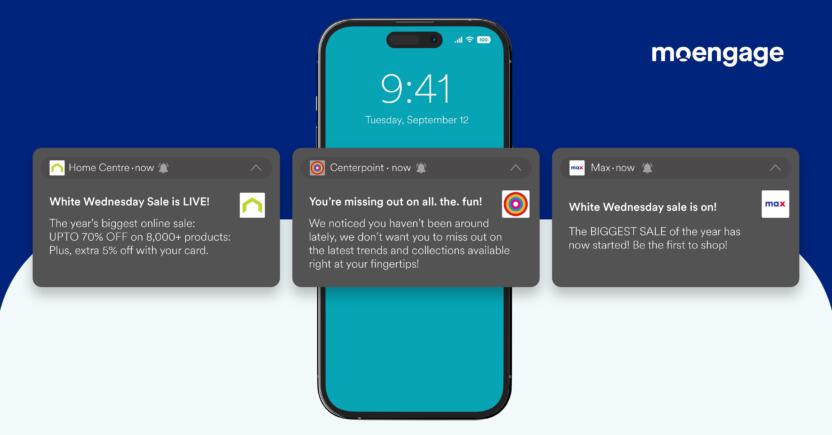
Why was this so powerful?
Landmark Group used segmentation to personalize campaigns based on real-time event triggers such as purchase, product search history, add to cart, etc. Furthermore, notifications were localized based on the customer’s preferred language.
Similarly, dormant customers were sent push notifications with exclusive offers in return for taking a short customer experience survey.
The insights gathered from running these campaigns allowed the brand to better understand its customers and cross-sell or upsell products to them.
Overall, Landmark Group was able to achieve the following:
- 35% uplift in subscribers within 28 days
- 56% uplift in purchases
- 65% increase in the retention rate of subscribers
| 💡 Read the full Landmark Group case study to know more. |
3. Beyond the Rack increased repeat visits by 50% within 3 months
Beyond the Rack is an online retailer of designer clothes with over 14 million customers. They used to send targeted remarketing emails with short-term offers based on the historical behavior and preferences of customers. However, the issue was that customers would often open the email too late and would not be able to take advantage of the offer.
Thus, the company implemented push notifications on its mobile website. By sending timely push notifications, Beyond the Rack increased the relevance and excitement of their campaigns, which resulted in higher sales.
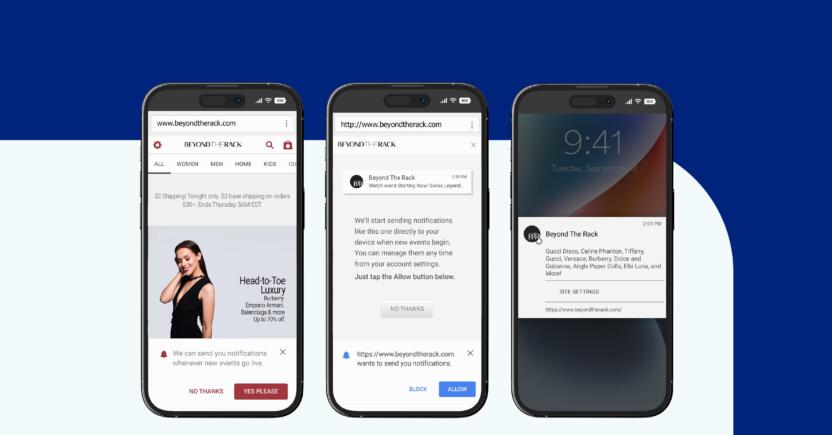
Why was this so powerful?
Push notifications added the timeliness and context that Beyond the Rack needed to increase CTR and revenue. Personalized messaging also ensured that customers could be engaged on a deeper level.
Overall, Beyond the Rack was able to achieve the following:
- 20% CTR for push notifications
- 50% increase in repeat visits within 3 months
- 72% more time spent on the website per visitor that came via push notifications
- 26% increase in spending by members who visited via push notifications
4. Maniology saw a 4.8% CTR with web push notifications campaign
Maniology, a cosmetics company offering nail polishes, nail stampings, and nail art tools, wanted to increase its customer touchpoints to reach a wider audience. The brand already had a good social media following and email subscribers. However, it wanted to capture customers who didn’t check these marketing platforms.
Alongside email campaigns, the brand released web push notifications that talked about new product launches, sales promos, and discounts. The idea was to reach customers who hadn’t subscribed to the brand’s other communication channels but had visited their website at least once.
By analyzing insights from the push notifications campaigns, Maniology was able to understand the preferences of their customers and their buying behavior and tweak campaigns to best respond to their needs.
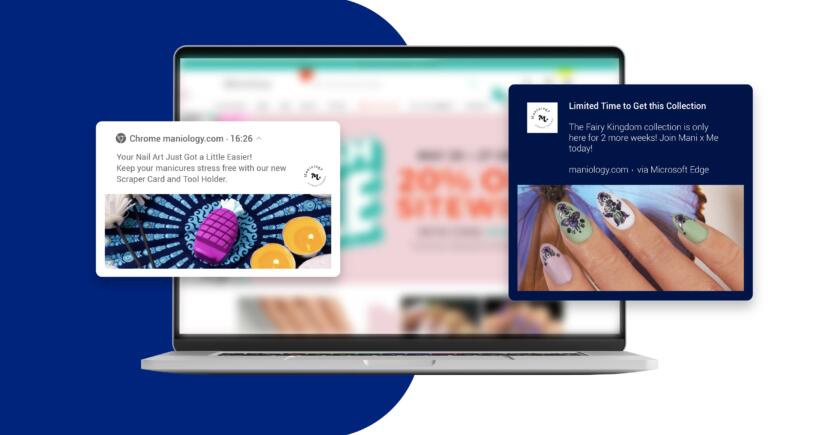
Why was this so powerful?
Maniology was able to personalize abandoned cart recovery reminders, re-engage shoppers through segmentation campaigns, and increase its subscriber base
Overall, Maniology was able to achieve the following:
- 4.8% CTR for web push notifications campaigns
- 4.7% of orders were attributed to push notifications
- 29.8% increase in average order value for orders attributed to push notifications
The Value of Push Notification Marketing Tools
Push notification marketing tools ensure that messages are directly delivered to the customer’s device to increase the likelihood of conversions.
With a push notification platform like MoEngage, you can enhance your push notification marketing strategy through:
- Automation: Push notification campaigns can be automated for triggers like cart abandonments, customer onboarding, and special events. By sending messages in a timely manner, customers can be engaged and encouraged to act. For example, you can set up an automatic reminder notification to coax customers back to their abandoned carts. Studies show that click rates of web push notifications can be improved to 15% by using automation tools.
- AI-driven efficiency: You can deliver the right push notifications to your customers in real time, triggered by the completion of the desired action. MoEngage’s Sherpa AI enables you to pick the right message to send at the correct trigger point. It also increases the likelihood of conversions by using the Intelligent Path Optimizer.
- Rich media: Within the no-code drag-and-drop editor, you can use stylized templates and designs for text overlay notifications and thin banner notifications. Consumers prefer noninvasive and personalized push notifications that show that the brand understands their preferences. With rich media formats, push notification open rates can be increased by 25%.
- Deliverability: Research shows that 15 out of 100 push notifications sent do not get delivered. If your push notifications don’t get reliably delivered, how can you hope to influence consumer behavior? MoEngage’s Push Amplification™ technology ensures that push notifications are delivered to all Android devices immediately. It acts as a fallback mechanism when Firebase Cloud Messaging (FCM) fails to deliver push notifications.
| 💡 Pro tip: You can use MoEngage’s website push and mobile push notification capabilities to understand customer behavior and preferences and send highly personalized messages on different devices. |
Personalized Push Notifications vs Email Marketing: Which is Better?
According to our Personalization Pulse Check Report, 43.5% of North American consumers interact with a brand on 2-3 channels before buying from them.
Also, the use cases of different channels can be very different. For e.g. push notifications are ideal for announcing flash sales and time-sensitive, personalized offers. Whereas, emails are more suitable for delivering onboarding guides, account information, in-depth product updates and tutorials, membership updates, and other long-form information.
While email marketing is a time-tested, mature approach to nurturing customers, personalized push notifications are a more recent tactic geared toward providing quick updates and nudges directly on the customer’s device.
Here are a few interesting findings from our Customer Engagement Benchmarks report for North America, that showcase the power of personalizing messages sent via email and push notifications:
- Emails personalized by customer journey can achieve up to 26% conversion rates (8.2X more than non-personalized emails).
- Emails personalized by customer behavior can achieve up to 93.3% conversion rates (29.3X more than non-personalized emails).
- iOS push notifications personalized by customer journey can achieve up to 28.1% conversion rates (3.3X more than non-personalized push notifications).
- iOS push notifications personalized by customer behavior can achieve up to 35.8% conversion rates (4.2X more than non-personalized push notifications).
These insights show that consumers demand personalization and flexibility in terms of the channels brands use to connect with them. Hence, you need both push notifications and emails to acquire, engage, and retain customers while ensuring you continue to implement omnichannel personalization.
Personalized Push Notifications: Contextual Marketing
In conclusion, push notifications have become an integral part of every successful marketing strategy. They are an effective way to help consumers discover and interact with your product.
Specifically, the ability to deliver personalized push notifications is a game changer, allowing businesses to engage with their customers more meaningfully. Various real-life examples have shown the undeniable benefits of personalized push notifications, from increased customer engagement and retention rates to higher conversion rates.
Furthermore, by implementing different push notification marketing strategies and utilizing tools like MoEngage, brands can optimize their campaigns with automation, AI, rich media templates, and ensure message deliverability.
In fact, through MoEngage’s push notifications platform, you can boost app engagement and increase in-app retention by 5X.
| To unlock the full potential of personalized push notifications and other powerful marketing channels, such as email, take a demo of MoEngage. Experience firsthand how MoEngage can revolutionize your marketing efforts and propel your brand toward success. |

